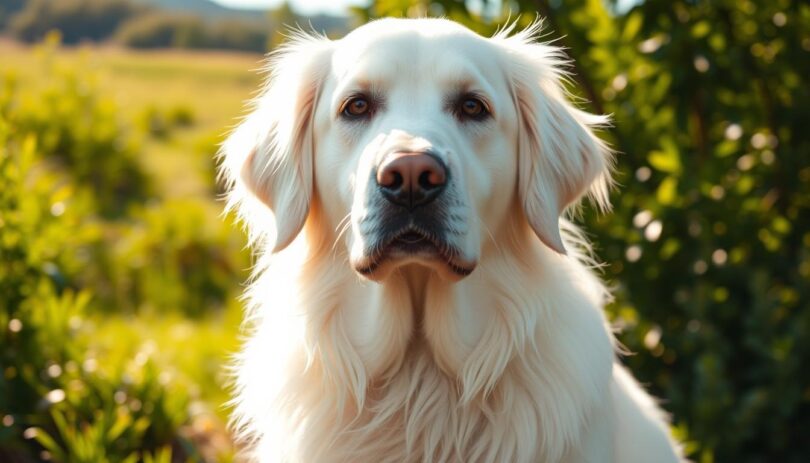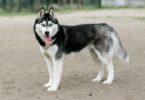Have you ever been captivated by a dog with a coat as pristine as freshly fallen snow? White Golden Retrievers are a beloved variation of the classic Golden Retriever, known for their all-white or mostly white coats and their incredibly friendly nature. These dogs are not just a visual delight but also known for their gentle, intelligent, and affectionate personalities.
In this article, we’ll delve into everything you need to know about White Golden Retrievers. From their history and physical characteristics to care tips, training, and health considerations, we’ll cover it all. Whether you’re a seasoned dog owner or considering bringing one of these beautiful dogs into your family, this guide will provide you with the insights you need to make informed decisions.
One of the most distinctive features of White Golden Retrievers is their coat. While traditional Golden Retrievers have a golden hue, White Golden Retrievers boast a coat that ranges from cream to almost pure white. This unique appearance, combined with their loyal and loving temperament, makes them a popular choice for many dog enthusiasts.
Reputable sources like Snowy Pines offer valuable insights into the breed, emphasizing the importance of understanding their lineage and genetics. This article blends scientific knowledge with practical advice, ensuring you’re well-prepared to care for your White Golden Retriever. So, let’s dive in and explore what makes this breed so special.
Overview of White Golden Retrievers
The White Golden Retriever, often referred to as an English Cream Golden Retriever, traces its origins back to the United Kingdom. Developed in the late 19th and early 20th centuries, this breed was bred to excel in hunting and retrieving game. Their lineage is deeply rooted in the foundation of the Golden Retriever breed, with a focus on a cream to white coat color. The British Kennel Club first recognized the English Cream Golden Retriever in 1911, and by 1925, the breed had made its way to the United States, where it was registered by the American Kennel Club.
The history of the White Golden Retriever has significantly influenced its physical characteristics and temperament. Unlike the American Golden Retriever, which often has a darker golden coat, the English Cream variety tends to have a lighter, creamier appearance. This difference in coat color is due to specific genetic factors, primarily the B, E, and C genes, which determine the production and distribution of pigmentation. The English Cream Golden Retriever’s temperament is also notable for being calmer and more gentle compared to its American counterpart, making it an excellent choice for families and as a therapy dog.
Key takeaways for potential owners include understanding the breed’s specific care needs, such as regular grooming to maintain their thick coat, and recognizing their friendly, loyal nature. The White Golden Retriever’s gentle disposition and high intelligence make them an ideal companion for active families and individuals alike.
The breed’s history and genetic makeup have also shaped its overall profile, with a stockier build and shorter legs compared to the American Golden Retriever. This physical structure, combined with their calm temperament, makes them well-suited for both family life and specialized roles such as service and therapy work. As a result, the White Golden Retriever has become a beloved choice for many dog enthusiasts seeking a loyal and affectionate companion.
Unique Physical Characteristics and Coat Care
White Golden Retrievers are known for their striking appearance, which sets them apart from other retriever breeds. Their coat, head shape, and ear characteristics are just a few features that make them unique.
Coat and Grooming Needs
Their coat is soft, thick, and water-resistant, requiring regular grooming. Weekly brushing helps maintain its health and reduce shedding. Trimming every few months is also essential to keep their coat in top condition.
Size and Build Insights
These dogs typically weigh between 55 to 75 pounds, with males being slightly larger than females. Their stocky build and shorter legs give them a sturdy appearance, making them well-suited for both family life and specialized roles.
Distinctive Appearance Features
A broad head and floppy ears are hallmark features. Their ears require regular cleaning to prevent infections. Their coat, which ranges from cream to almost pure white, is a key distinguishing feature compared to other retrievers.
Temperament and Personality Traits
White Golden Retrievers are celebrated for their exceptional temperament, making them a beloved companion for many families. Their friendly and loyal disposition, combined with a calm demeanor, creates a perfect blend of traits that suit both active households and those seeking a gentle pet.
Friendly and Loyal Disposition
These dogs are known for their intelligence and eagerness to please, which makes training a smooth process. Their calm nature, exhibited by about 60% of Golden Retrievers, makes them ideal for families and therapy work. With less than 5% of reported aggressive behavior, they are a safe choice for homes with children.
Social Behavior with Family and Other Pets
They interact wonderfully with children and other pets, thanks to their social temperament. About 90% of owners describe them as affectionate and friendly, even with strangers. Their adaptability and social behavior make them excellent family dogs, capable of thriving in various environments.
Despite their gentle nature, they require daily exercise to stay energetic and healthy. This balance of calmness and energy aligns with the retriever breed standard, ensuring they are both loving companions and active participants in family life.
Health Concerns and Lifespan Insights
Understanding the health concerns and lifespan of White Golden Retrievers is crucial for any prospective owner. Like many breeds, they face specific health challenges that can affect their quality of life and longevity.
Common Health Issues
White Golden Retrievers are prone to hip and elbow dysplasia, which can lead to pain and mobility issues. Eye problems, such as pigmentary uveitis, are also common, often developing as they age. Regular veterinary check-ups are essential for early detection and management of these conditions.
Lifespan and Preventative Care
On average, White Golden Retrievers live between 10 to 12 years. With proper care, including a balanced diet, regular exercise, and routine health screenings, some may live up to 14 years. The American Kennel Club emphasizes the importance of working with reputable breeders who prioritize health screenings to minimize genetic risks.
Preventative care plays a vital role in extending their lifespan. Regular grooming, dental care, and a nutritious diet are key. Ensuring they get adequate exercise and maintaining a healthy weight can prevent obesity-related issues. Mental stimulation through activities and socialization also contributes to their overall well-being.
Training and Socialization Tips
Training is a cornerstone of raising a well-behaved and well-adjusted White Golden Retriever. Positive reinforcement is key, using treats and praise to nurture good behavior. Short, frequent sessions are ideal, especially for puppies with shorter attention spans.
Early Training Strategies
Start training early, using positive reinforcement techniques. This approach helps build a strong bond and establishes good habits. Keep sessions short and fun to maintain your puppy’s interest.
Overcoming Common Behavioral Challenges
Address behavioral challenges like chewing or barking by redirecting your puppy’s attention. Consistent routines and structured training levels help prevent unwanted habits and ensure your dog grows into a well-mannered companion.
Socialization is crucial for developing confidence. Introduce your puppy to various environments and other dogs to help them interact calmly. Early exposure prevents anxiety and aggression, fostering a friendly temperament.
Training not only teaches obedience but also strengthens the bond between you and your dog. With patience and consistency, your White Golden Retriever will thrive as a loving and loyal companion.
Daily Exercise and Activity Guidelines
Ensuring your pet gets the right amount of physical and mental stimulation is key to maintaining their health and happiness. A golden retriever puppy needs a balanced routine that includes both exercise and playtime to prevent boredom and stress.
Physical Exercise Requirements
Golden Retrievers are energetic dogs that require regular physical activity. Daily walks, runs, and play sessions help release their abundant energy. Activities like fetch and safe off-leash play in open areas are excellent ways to keep them active. For puppies, the exercise time should start at five minutes per month of age, increasing gradually as they grow. Adult dogs benefit from at least 20-30 minutes of exercise twice a day. Reputable breeders like Snowy Pines recommend structuring exercise routines according to your dog’s age and ability to ensure safety and effectiveness.
Mental Stimulation Activities
Mental stimulation is just as important as physical exercise. Interactive games, puzzle toys, and obedience training can keep your pet engaged and happy. These activities not only challenge their minds but also strengthen the bond between you and your dog. A healthy, happy pet is less likely to develop behavioral issues like excessive barking or destructive chewing. By combining physical exercise with mental stimulation, you can create a well-rounded routine that supports their overall health and well-being.
Feeding Requirements and Nutritional Advice
Nutrition plays a vital role in the health and vitality of your pet. A well-balanced diet tailored to your dog’s age, weight, and activity level is essential for maintaining their energy levels and overall well-being. Proper feeding habits can prevent health issues like obesity and ensure your dog’s coat stays healthy and vibrant.
Balanced Diet Essentials
A high-quality diet rich in protein and healthy fats is crucial for your pet. Look for dog food that contains at least 25% protein, with omega-3 fatty acids to support skin and coat health. Antioxidants can also help reduce the risk of certain health issues, while joint-friendly ingredients like glucosamine promote mobility.
Portion Control and Feeding Schedules
Monitoring portion sizes is key to preventing overfeeding. Most adult dogs need 2 to 3 cups of dry food daily, divided into two meals. Puppies, especially those under six months, may require 3 to 4 smaller meals to support their rapid growth. Reputable breeders, such as those at Snowy Pines, often provide detailed feeding plans tailored to your dog’s specific needs.
A proper diet not only supports your dog’s physical health but also contributes to their mental well-being. Regular veterinary check-ups can help ensure you’re meeting their nutritional needs and address any potential issues early on. By focusing on quality and balance, you can help your pet thrive and maintain their energetic and affectionate nature.
Understanding White Golden Retriever Genetics
The genetics behind a White Golden Retriever’s appearance are fascinating and play a crucial role in their distinct features. This section explores the genetic factors that contribute to their unique coat color and overall characteristics.
Genetic Coat Color Factors
The coat color of White Golden Retrievers is determined by three key genes: B, E, and C. These genes work together to create the range of colors seen in the breed, from the traditional golden hues to the cream and white coats.
The Role of B, E, and C Genes
The B gene influences the production of black and brown pigments, while the E gene controls whether these pigments are deposited into the coat. The C gene determines the intensity of the color. When these genes interact, they can produce the lighter, creamier coats seen in White Golden Retrievers.
Breeders carefully select for these genetic traits to produce dogs with the desired coat characteristics. Genetic testing is essential to ensure healthy lines and avoid inherited health issues.
Comparing English and American Lineages
When exploring the world of golden retrievers, it’s essential to understand the distinctions between English and American lineages. These differences, while subtle, can significantly impact your decision when choosing a pet.
Physical and Temperament Comparisons
English Cream Golden Retrievers, often called White Golden Retrievers, tend to have a stockier build and broader skulls compared to their American counterparts. Their coats are lighter, ranging from cream to almost pure white, due to specific genetic factors. This lineage typically displays a calmer demeanor, making them ideal for families seeking a gentle companion.
American Golden Retrievers, on the other hand, are generally taller and leaner, with coats that range from light golden to dark golden. They are known for their higher energy levels and are often more active, especially in their first few years of life. This makes them excellent choices for active households or those who enjoy outdoor activities.
Both lineages meet the breed standards set by the American Kennel Club, ensuring their legitimacy and quality. Despite their differences, they share the same loyal and affectionate nature that makes golden retrievers a beloved breed worldwide.
Understanding these lineage differences can help you make an informed decision about which type of golden retriever best fits your lifestyle and preferences. Whether you prefer the calm nature of an English Cream or the energetic spirit of an American Golden, both promise to bring joy and companionship into your life.
Choosing a Reputable Breeder for Your White Golden Retriever
Selecting a reputable breeder is the first step toward bringing a healthy and well-adjusted White Golden Retriever into your family. A trustworthy breeder ensures your puppy comes from a lineage of health and good temperament, which is crucial for a long, happy life together.
Avoiding Scams and Ensuring Proper Health Screenings
When searching for a breeder, be cautious of red flags such as multiple breeds on site and no health guarantees. Reputable breeders prioritize health screenings for conditions like hip dysplasia and eye issues. Always verify certifications through organizations like the Orthopedic Foundation for Animals (OFA). Visit Dog Tips for more insights on selecting the right breeder.
Questions to Ask During the Breeder Interview
Ask about health certifications, socialization practices, and the living conditions of parent dogs. Reputable breeders will discuss these openly and provide references. They often remain involved in your dog’s life, offering guidance and support.
A well-chosen breeder is key to a healthy, well-adjusted companion. Ensure you request necessary documentation, including kennel club certifications and health screenings, to make an informed decision.
Parting Thoughts and Next Steps
Bringing a White Golden Retriever into your life is a decision that comes with immense joy and responsibility. As you’ve learned, this breed offers a unique blend of beauty, intelligence, and affection. From their gentle nature to their striking appearance, these dogs are truly special companions.
Your journey doesn’t end here. Take the time to research further and ask questions to ensure this breed is the perfect fit for your family. Reputable breeders, like those at Snowy Pines, can provide valuable insights and guidance to help you make an informed decision.
A well-cared-for White Golden Retriever can thrive as a loving family companion. With proper training, regular exercise, and attentive care, you’ll build a lifelong bond with your pet. Remember, every detail—from their diet to their grooming—matters in creating a happy, healthy home for your new friend.
Visit reputable breeder websites and prepare your home with love and care. The time you invest now will reward you with a loyal, loving companion for years to come. Take your time, make informed decisions, and welcome your new White Golden Retriever with an open heart.
FAQ
What makes White Golden Retrievers different from other Retrievers?
White Golden Retrievers, also known as English Cream Retrievers, are prized for their light-colored coats and gentle temperament. They are part of the same breed as other Retrievers but often have distinct physical and personality traits.
Are White Golden Retrievers considered a separate breed?
No, they are not a separate breed. They are a variation of the Golden Retriever, recognized by their light cream to white coat color, but they share the same breed standard as other Retrievers.
How do I care for a White Golden Retriever’s coat?
Regular brushing is essential to prevent matting and tangling. They need weekly grooming sessions and occasional baths to maintain their coat’s health and appearance.
Are White Golden Retrievers good family dogs?
Absolutely. They are known for their friendly, loyal, and patient nature, making them an excellent choice for families with children or for first-time dog owners.










Leave a Comment